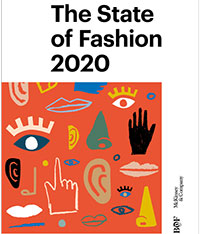FW
American rating agency Moody’s says, the most exposed sectors are those linked to travel and discretionary spending, such as fashion or retail, excluding the alimentary sector.
Fashion will take the biggest hit from the coronavirus in the sector. According to Moody’s, the rating agency, the sectors most exposed to this unusual situation are those linked to discretionary spending and travel.
The organisation cites fashion, automotive, durable goods, gaming, tourism and non-food sectors as the most vulnerable to the crisis. The evaluation has been carried out considering a normalization of economic activity in the second half of the year.
Among the sectors with reasonable exposure are beverages, steel producers and the chemical industry, among others, while the least exposed are real estate, food, telecommunications, defense, and construction.
India's export of textiles and garments may decline by 40 per cent in the following months. The Coronavirus has halted shipments. The spread of the virus, especially in the United States, and leading markets of Europe like Spain, Portugal, Italy and even the United Kingdom has led to cancellation/deferment of orders on a very large scale. Buyers and major retail shops importing home textiles from India have put further business on hold. Exports of cotton yarns and fabrics have virtually come to a standstill. Besides affecting order flows, this could potentially result in the renegotiation of realisations as well as an elongated receivables cycle for the exporters.
Urgent policy interventions/support are needed in order to provide fiscal relief and ensure credit flow with an extension of the Remission of State and Central Taxes and Levies (RoSCTL) scheme to cotton yarn and fabrics so that India’s competitiveness is enhanced at a time of falling markets. Also, there is a need to extend the interest subvention of three per cent beyond March 31, 2020, and also cover cotton yarn within that to ease the financial burden. A relief package is urgently needed. Demand for textile products and domestic sales have also come to a grinding halt.
As pr OTEXA, import of brassieres by the US fell 23.03 per cent to $1,847.57 million in January 2020 on Y-o-Y basis as against $239.79 million in January 2019. The major downfall was recorded from China’s side which slumped drastically by 39.56 per cent to export $65.75 million worth of brassieres. Markedly, the share of China in total brassieres import value of USA has been reduced to 35.62 per cent in January 2020 from 45.37 per cent from a year earlier.
Vietnam clocked in $30.12 million in brassieres export to US in January 2020 falling by 7.20 per cent. The imports of Sri Lanka, Indonesia, India, and Cambodia also declined to $22 million, $15 million, $3 million and $2.80 million, respectively.
Hermès will close all its production sites in France until the end of March due to the Covid-19 pandemic. The company has 9,500 employees in France. In all, it operates 52 production sites. Of these, 42 are located in France. They include tanneries, garment workshops, and leather goods and porcelain factories. However, the decision doesn't apply to the Hermès Parfums factory in Vaudreuil, whose operations cannot be halted and where hygienic measures, already very stringent, have been further boosted. Closure of rest of the production site will take place partially and gradually depending on the nature of the various operations.
With regards office staff, Hermès recommends employees to work from home and it will continue to pay its employees during this entire period and in addition to statutory provisions. Leather and saddlery goods are the core business of Hermès - world renowned for the Birkin and Kelly handbags - and account for nearly half of its revenue, which in 2019 was just shy of €7 billion.
Bangladesh wants to secure more trade benefits from China as a least developed country rather than sign a free trade agreement. China offers duty-free entry for 97 per cent of all Bangladesh products under the LDC category. China is Bangladesh’s largest bilateral trade partner. Import duty levied on Chinese products accounts for 30 per cent of the total revenue collected by Bangladesh from import duties annually. China is a vital trade partner of Bangladesh for various reasons. For instance, the country’s garment industry is heavily reliant on Chinese fabrics although local manufacturers can supply nearly 80 per cent of the yarn required by the knitwear sector. Bangladesh’s woven garment makers import nearly 60 per cent of all the fabrics they require directly from China as local weavers cannot supply adequate raw materials. In total, apparel makers in the country source 46 per cent of their raw materials from China. Moreovre Bangladesh is dependent on Chinese dyes, chemicals and capital machinery.
Apparel exports from Bangladesh to China are increasing with time as a section of consumers in the middle income bracket cannot afford the high-end garment items made in China. This is why they depend on cheaper Bangladesh products. The cost of apparel production in China has gone through the roof due to a shortage of skilled workforce.
The coronavirus disease (COVID-19) is affecting every sphere of life including manufacturing activities, businesses, etc., across the globe and India is also not spared from the panic situation. The textile industry predominantly employs migrant workers from different States and also a large population comes for work from far off places using public transport. Under the current scenario, especially the constant preventing measures being taken and awareness created by the Government to fight against the Coronavirus pandemic, majority of the workers are not reporting for work and the migrant workers are also returning to their native places.
This situation is likely to intensify and result in mass stoppage of production in the industry. With the expected steep reduction in demand due to sudden stoppage of exports / imports and also domestic sales due to the closure of malls and retail showrooms, the industry is likely to face unprecedented and severe losses and needs immediate financial relief to mitigate the crisis. Therefore, the textile industry, being labor and capital intensive, needs immediate help to tide over the worst ever crisis being faced by the industry.
Ashwin Chandran, Chairman, The Southern India Mills’ Association (SIMA) informed that the association has sent a representation to the Prime Minister appealing him to mandate the banks to provide a moratorium of one year (April 01, 2020 to March 31, 2021) for repayment of principal and interest amount to the banks to enable the Indian textiles and clothing industry to tide over the crisis. He stated that the country has never witnessed such a crisis situation before and therefore, the textiles and clothing industry requires a helping hand from the Government through this measure. Such a relief, if extended, will go a long way to help the industry to tide over the crisis and ensure the survival.
 Singapore-based INA Systems offers customised conveyor systems for garments and home textile manufacturers. The company specialises in intelligent material handling systems, box storage, MES and intelligent transport, as well as sorting systems which help manufacturers improve their production processes. It recently participated in the GTE 2020 exhibition held in New Delhi. Manpreet Singh, Manager-India of the company elaborates on its operations and the current market in India.
Singapore-based INA Systems offers customised conveyor systems for garments and home textile manufacturers. The company specialises in intelligent material handling systems, box storage, MES and intelligent transport, as well as sorting systems which help manufacturers improve their production processes. It recently participated in the GTE 2020 exhibition held in New Delhi. Manpreet Singh, Manager-India of the company elaborates on its operations and the current market in India.
The future of Indian garment and textile machinery market is very bright as increasing labor cost is fuelling demand for such machines in the country. “The conventional modes of production take a lot of time for handling and transportation of goods. Automation can help manufacturers reduce this time and increase their WAP and outputs by 20 percent to 25 percent. However, the awareness on automation is currently quite low in India,” avers Singh.
The Indian customer needs to be made aware of the benefits of automation. “The domestic Indian market offers great opportunities for manufacturers like us,” notes Singh. “We have been getting multiple orders as customers from across India as well as from foreign countries have started adopting our systems in the last two years,” he adds. “Some of our customers also run showroom chains in India.”
Though Bangladesh has an edge over India as it does have a duty structure, the Indian garment and textile sector offers a huge potential. “Domestic players in the both eastern and western parts of country are registering a good growth,” adds Singh.
"With many markets witnessing slower growth and low consumer confidence, the fashion industry is going through a seismic transformation. As the recently released ‘The State of Fashion 2020’ report by The Business of Fashion reveals, under pressure brands are embracing digital operations, boosting earnings while tackling sustainability issues."
 With many markets witnessing slower growth and low consumer confidence, the fashion industry is going through a seismic transformation. As the recently released ‘The State of Fashion 2020’ report by The Business of Fashion reveals, under pressure brands are embracing digital operations, boosting earnings while tackling sustainability issues.
With many markets witnessing slower growth and low consumer confidence, the fashion industry is going through a seismic transformation. As the recently released ‘The State of Fashion 2020’ report by The Business of Fashion reveals, under pressure brands are embracing digital operations, boosting earnings while tackling sustainability issues.
The report identifies the top 10 fashion industry themes for year 2020. New channels, markets and research are creating opportunities for companies that find the right formula, says the report. A new breed of super winners is emerging who are attracting the best talents in the industry.
However, the outlook for 2020 appears to be subdued as according to 55 percent respondents conditions will worsen in the year. Fashion companies may become more resilient in 2020 and assign additional resources to understanding risks and putting forward solutions. Also, Chinese brands may direct some of their attention towards other growth markets like India, South Asia, Russia and Middle East.
Focus on social media trends and content creation
As social media platforms will focus on high-quality or user-generated content, storytelling will become more important in the months ahead. These platforms will be used to tap into the “drop culture” associated with streetwear labels. By 2023, these platforms could account for a fifth of all online sales in China, a staggering $166 billion amid a pervasive culture of innovation. Brands will spend time evaluating these emerging social media trends and focus on content creation that strikes a chord across channels.
important in the months ahead. These platforms will be used to tap into the “drop culture” associated with streetwear labels. By 2023, these platforms could account for a fifth of all online sales in China, a staggering $166 billion amid a pervasive culture of innovation. Brands will spend time evaluating these emerging social media trends and focus on content creation that strikes a chord across channels.
Fashion retailers will set up stores focusing on service, convenience, personalization, and customer experience. Smaller in size than existing outlets, each of these stores will have their own look and feel depending on location. They will use cutting-edge design, highly focused assortments, and experiential elements to strike a chord with local communities. Some may be pop-ups, while others will be found in new corners of established neighborhoods.
Acceleration of sustainability initiatives
This year will also see the fashion industry grow its sustainability engagement as brands will develop new fabrics, cut destruction of unsold goods and ensure products can be repaired or recycled. Some brands have committed to radical transparency in the supply chain, and have seen positive results, while several e-commerce platforms have enabled searches for sustainable brands.
Some of fashion’s biggest names will join the ‘materials revolution,’ in 2020 as they will opt for synthetic and reengineered fibers, including biofabricated leather and e-textiles. This will not only enhance their design palette but also offer them greater functionality, and range of commercial opportunities.
Rise in inclusive culture
Chief diversity and inclusion officers will rule as customers and stakeholders will keep a close eye on developments. Brands will launch ranges catering to underserved demographics, from brands for people with disabilities, such as IZ Adaptive, to Good American, which offers jeans in a wide range of tailored sizes, and trans-friendly lingerie brand Carmen Liu Lingerie.
Larger share for Asian manufacturers
Asian manufacturers will get a larger share of global mass market, as they will continue to move up the value chain and leverage in-house design capabilities and e-commerce platforms such as Amazon. A significant driver of this growth will be the rising consumer demand for these brands. To stay ahead of the game, international brands need to strengthen their value propositions in the months ahead.
Digital companies to reevaluate operations
Brands are obsessed with making their digital operations a success by offering compelling customer experiences and streamlined operations. However, some of the world’s largest companies are divesting themselves of e-commerce businesses. These companies will need to reevaluate their business models in 2020 and seek levers to boost their revenues.
As a result of COVID-19, Tirupur has to pay five to 15 per cent more for synthetic dyes. Availability of dyes and pigments has decreased by 20 per cent. On an average, over 470 units in Tirupur require 500 tons of synthetic dyes every month. Now, its unavailability has forced traders to look for alternatives — natural dyes. However, it is not possible to procure them in such huge quantities, considering their limited sources. Besides, when a unit uses synthetic dyes on fabric, it is not practically feasible to make a switch to, or experiment with, natural dyes.
Although chemical industries in Gujarat and Maharashtra meet nearly 80 per cent of Tirupur’s demand for synthetic dyes and chemicals, it is China that supplies them with the raw materials. However, pigment production in these states has taken a hit as shipping from Chinese ports has slowed down in the past four weeks.
A hike in the price of pigments is sure to increase the fabric rate as well. There may be a 15 per cent to 20 per cent increase in cloth price though the difference in rates will reflect on garment orders, both domestic and export, only in the next financial year.
Textile Fairs India will be held in New Delhi, July 23 to 25, 2020, along with Fashion Connect and Yarnex. The show will bring together clothing and textile manufacturers, accessories businesses, wholesalers, buyers, and exporters to network and forecast trends for the upcoming season. Countries will take part in the event and showcase textiles such as yarns and fibers, trims and embellishments, and readymade garments. A special focus will be on sustainable fashion. Industry professionals will discuss how to make production more environmentally friendly and a dedicated sustainable fashion showcase will shine the spotlight on recycled and upcycled clothing. A number of design and product awards will also feature during the event. Yarnex brings together manufacturers and suppliers of fibers, yarns and related services to showcase their merchandise to buyers from across the world. F&A is a fashion and accessories show. Fashion Connect connects clothing brands and contract manufacturers with the entire retail fraternity. Besides being a platform for sourcing, the event also disseminates information on fashion trends.
Textile Fairs India launched in 2004 and is run by textile sourcing exhibition business SS Textile Media. The business has also hosted a number of trade shows in knitwear capital Tirupur and in Ludhiana.












